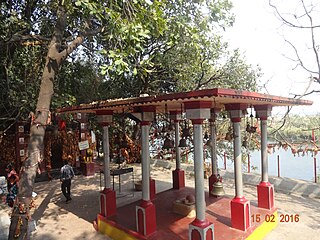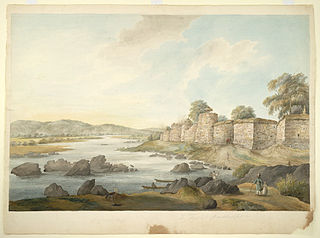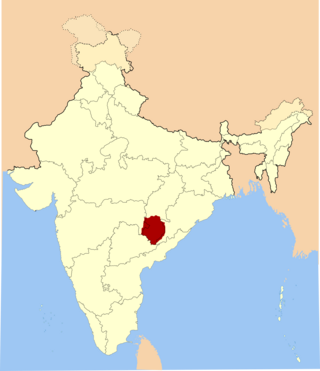
Odia is an Indo-Aryan classical language spoken in the Indian state of Odisha. It is the official language in Odisha, where native speakers make up 82% of the population, and it is also spoken in parts of West Bengal, Jharkhand, Andhra Pradesh and Chhattisgarh. Odia is one of the many official languages of India; it is the official language of Odisha and the second official language of Jharkhand.
The Odia script is a Brahmic script used to write primarily Odia language and others including Sanskrit and other regional languages. It is one of the official scripts of the Indian Republic. The script has developed over more than 1000 years from a variant of Siddhaṃ script which was used in Eastern India, where the characteristic top line transformed into a distinct round umbrella shape due to the influence of palm leaf manuscripts and also being influenced by the neighbouring scripts from the Western and Southern regions.

Sambalpur District is a district in the western part of state of Odisha, India. The historic city of Sambalpur is the district headquarters.

Kurukh, also Kurux, Oraon or Uranw, is a North Dravidian language spoken by the Kurukh (Oraon) and Kisan people of East India. It is spoken by about two million people in the Indian states of Jharkhand, Chhattisgarh, Odisha, West Bengal, Assam, Bihar and Tripura, as well as by 65,000 in northern Bangladesh, 28,600 of a dialect called Uranw in Nepal and about 5,000 in Bhutan. The most closely related language to Kurukh is Malto; together with Brahui, all three languages form the North Dravidian branch of the Dravidian language family. It is marked as being in a "vulnerable" state in UNESCO's list of endangered languages. The Kisan dialect has 206,100 speakers as of 2011.

Sambalpur is the fifth largest city in the Indian State of Odisha. It is located on the banks of river Mahanadi, with a population of 335,761. Prehistoric settlements have been recorded there. It is the home of the Sambalpuri sari.

Halbi is an Eastern Indo-Aryan language, transitional between Odia and Marathi. It is spoken by at least 766,297 people across the central part of India.
Tamil phonology is characterised by the presence of "true-subapical" retroflex consonants and multiple rhotic consonants. Its script does not distinguish between voiced and unvoiced consonants; phonetically, voice is assigned depending on a consonant's position in a word, voiced intervocalically and after nasals except when geminated. Tamil phonology permits few consonant clusters, which can never be word initial.
The Gujarati language is an Indo-Aryan language native to the Indian state of Gujarat. Much of its phonology is derived from Sanskrit.
Hindustani is the lingua franca of northern India and Pakistan, and through its two standardized registers, Hindi and Urdu, a co-official language of India and co-official and national language of Pakistan respectively. Phonological differences between the two standards are minimal.
Mundari (Munɖari) is a Munda language of the Austroasiatic language family spoken by the Munda tribes in eastern Indian states of Jharkhand, Odisha and West Bengal and northern Rangpur Division of Bangladesh. It is closely related to Santali. Mundari Bani, a script specifically to write Mundari, was invented by Rohidas Singh Nag. It has also been written in the Devanagari, Odia, Bengali, and Latin writing systems.
Nepali is the national language of Nepal. Besides being spoken as a mother tongue by more than 48% of the population of Nepal, it is also spoken in Bhutan and India. The language is recognized in the Nepali constitution as an official language of Nepal.
Kalahandia is a dialect of Odia spoken in the region of Kalahandi and Nuapada district of Odisha state in India. Local weekly Odia newspaper such as Arjji and Kalahandi Express publish articles in standard Odia Form and Kalahandia Odia Form.

Dr. Haldhar Nag is a Sambalpuri poet and writer from Bargarh, Odisha, India. Popularly known as "Lok Kabi Ratna". He was awarded Padma Shri, the fourth highest civilian award of India by Government of India in 2016.
Kosalananda Kavyam is a Sanskrit work written on a palm-leaf manuscript in Odia script, in 1663 CE by Pandit Gangadhara Mishra. The work is an important epic of Sanskrit literature about the history of Chauhan rule in Western Odisha region. Pandit Mishra was the court poet of Sambalpur King Baliarsingh Deva. He was born at Biraramchandrapur sasana of Puri and was the descendant of Sambhukara and Vidyakara, scholars and poets of Puri.
Schwa deletion, or schwa syncope, is a phenomenon that sometimes occurs in Assamese, Hindi, Urdu, Bengali, Kashmiri, Punjabi, Gujarati, and several other Indo-Aryan languages with schwas that are implicit in their written scripts. Languages like Marathi and Maithili with increased influence from other languages through coming into contact with them—also show a similar phenomenon. Some schwas are obligatorily deleted in pronunciation even if the script suggests otherwise. Here, schwa refers to an inherent vowel in the respective abugida scripts, not necessarily pronounced as schwa.

Baleswari Odia, also Northern Odia or North Balasore Odia, is a dialect of Odia spoken in the northern regions of Indian state of Odisha. It is spoken in the districts of Balasore, Bhadrak, Mayurbhanj and Kendujhar.
Sambalpuri Odia drama are a typical drama performance in Sambalpuri Odia language of Odisha, India.
Konkani alphabets refers to the five different scripts currently used to write the Konkani language.
Sundargadi Odia or Northwestern Odia is a dialect of the Odia language spoken in the Sundergarh district and parts of adjoining districts of Odisha. It is also spoken in the nearby districts of Jashpur of Chhattisgarh and Simdega of Jharkhand.
Desia, also Desiya or Desia Odia or Koraputi Odia or Southwestern Odia, is an Indo-Aryan language variety spoken in Koraput, Nabarangpur, Rayagada, Malkangiri districts Odisha and in the hilly regions of Vishakhapatnam and Vizianagaram districts of Andhra Pradesh. The variant spoken in Koraput is called Koraputia.









